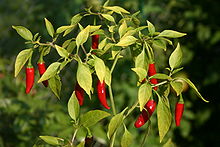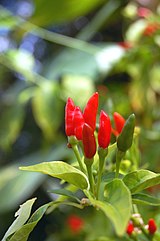From Wikipedia, the free encyclopedia
For a similar variety of Capsicum frutescens better known as peri-peri, see African birdseye.
| This article's factual accuracy is disputed. Please see the relevant discussion on the talk page. (November 2009) |
| The examples and perspective in this article may not represent a worldwide view of the subject. Please improve this article and discuss the issue on the talk page. (November 2009) |
| This article contains Thai text. Without proper rendering support, you may see question marks, boxes, or other symbols instead of Thai script. |
 | |
| Heat | |
|---|---|
| Scoville rating | 50,000–100,000 |
Bird's eye chili (Thai: พริกขี้หนู, RTGS: phrik khi nu, IPA: [pʰrík kʰîː nǔː], literal: mouse dropping chili; Tagalog: siling labuyo) is a chili pepper of the species Capsicum frutescens L. in the family Solanaceae, commonly found in Cambodia, Laos, Vietnam, Thailand, Malaysia, Indonesia, the Philippines and Singapore. It can also be found in India, mainly Kerala, where it is used in traditional dishes of the Kerala cuisine (pronounced in Malayalam as kanthari mulagu). This species (known as kochchi in sinhalese) is also found in rural areas of Sri Lanka, where it is used as a substitute for green chillies. It is also a main ingredient in kochchi sambal, a salad made using freshly scraped coconut ground with thai chillies and seasoned with salt and lime juice.
The term Bird's eye chili is also used for the North American Chiltepin pepper, both due to their small round shape and because they're widely spread by birds.
Contents[hide] |
[edit] Cultivars
[edit] Description
The bird's eye chili plant is a perennial with small, tapering fruits, often 2-3, at a node. The fruits of most varieties are red, some are yellow, purple or black. The fruits are very pungent. The flowers are greenish white or yellowish white.[1]Taxonomically, it has long been thought that the bird's eye chili belongs to Capsicum frutescens L.,[2][3][3] but there are now some who list the bird's eye chili as belonging to Capsicum chinense.[4]
The bird's eye chili is small but packs quite a lot of heat. At one time it was even listed as the hottest chili in the Guinness Book of World Records but other hotter varieties of chili have since been identified. It measures around 50,000-100,000 Scoville units which is at the lower end of the range for the hotter Habanero chili.
Characteristics of the Birds Eye Chili plant[5]

Bird's eye chilies growing wild on Saipan.
- Plant height - up to 2meters
- Stem color - Green
- Leaf color - Green
- Leaf size - 3–8 cm by 2–4 cm
- Fruit color at maturity - green, orange and red
- Fruit shape - conical
- Fruit length - 2–3 cm
- Fruit width at shoulder - .5 cm
- Fruit weight - 2-3 grams
- Fruit surface - smooth
- Seed color - Light tan
- Seeds per chili - 10-20
[edit] Origins
Chilies found around the world today have their origins in Central America and South America. Chilies were spread by the Spanish and the Portuguese in their quest to build a global empire and are still grown in their former colonies in Africa and Asia. The chili varieties found in Southeast Asia today were first grown by Spanish and the Portuguese colonists and traders.[edit] Common names
| This section does not cite any references or sources. Please help improve this article by adding citations to reliable sources. Unsourced material may be challenged and removed. (November 2009) |
The chilies may also be referred to as cili padi (cili pronounced "chili") in parts of Malaysia because their small size reminds people of the small grained rice eaten as a staple in the region. in the northern parts of Malaysia, this chili is known as cabai burung or bird chili as birds like to eat this variety of chili.
As well as the Malay word, Thai chilies can also be referred to as cabe rawit (Indonesian), lombok rawit (Javanese), cengis (Banyumasan language), cengek (Sundanese), phrik khi nu (พริกขี้หนู, Thai), Thai hot, Thai dragon (due to its resemblance to claws), siling labuyo (Filipino), ladâ, and boonie pepper (the Anglicized name).
[edit] Uses
[edit] Cooking

Phrik nam pla - bird's eye chili with fish sauce and lime juice - is served with nearly every Thai meal
[edit] Ornamentals
The more decorative, but slightly less pungent variety, sometimes known as Thai Ornamental, has peppers that point upward on the plant, and go from green to yellow, orange, and then red. It is the basis for the hybrid Numex twilight, essentially the same but less pungent and starting with purple fruit, creating a rainbow effect, and among the group of Capsicum annuum. These peppers can grow wild in places like Saipan and Guam. The Chinese in Southeast Asia call this pepper 'the chili that points to the sky'.[edit] Medicine
In medicine, the bird's eye chili was traditionally used to ease arthritis and rheumatism, and also as a cure for dyspepsia, flatulence, and toothache.[7]It can also be used as a natural insect repellent or pesticide when mixed with water.[8][9]
No comments:
Post a Comment